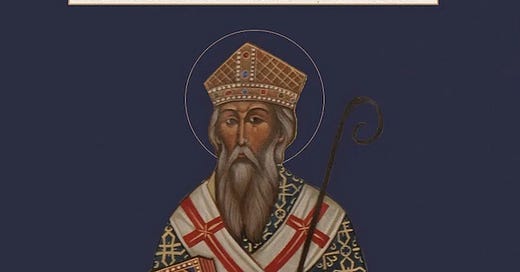He who was the Son of God became the Son of Man, that man, having been taken into the Word and receiving the adoption, might become the son of God.
This last year, I’ve been working on a book about Irenaeus (Eye-Wren-Aye-Us), an important theologian among the earliest churches in the second century.
The book is part of the “Patristic Essentials” series with Fontes Press and has now been published!
You can order it from Amazon or from the publisher website. If you like it, consider leaving a review! If you hate it, consider telling as few people as possible.
Removing Roadblocks to Reading Irenaeus
One of the aims of the book (and series) is to provide an entry point for someone wanting to read or study Irenaeus but doesn’t know where to start. For Irenaeus, there are several reasons why his major works are sometimes neglected.
First, Irenaeus’s most well-known work Against Heresies is a long, complex, and difficult book to work through as a whole. Only the most dedicated students will read this work from start to finish. A central reason for this difficulty is the complicated nature of Books 1–2 where Irenaeus delves into various gnostic systems at a granular level. As one editor has noted, in these first two books especially, “the patience of the reader is sorely tried, in following our author through those mazes of absurdity which he treads, in explaining and refuting these Gnostic speculations.”
Second, Irenaeus is usually associated with his strongly worded critiques and wide-ranging polemical arguments against the various heretical teachers. This has led many scholars and casual readers to view Irenaeus with varying levels of suspicion. These two factors (the difficulty of Books 1–2 and the notorious reputation of an unflinching “heresiologist”) sometimes discourage people from considering Irenaeus’s body of writing in its entirety and on its own terms.
Finally, the available English translations of Against Heresies are generally antiquated and usually only available through larger collections in the public domain like the Ante-Nicene Fathers series.
This volume seeks to help readers of Irenaeus's works navigate each of these difficulties. Accordingly, the introduction above briefly situates Irenaeus in his historical context and notes the theological contributions he makes to the developing doctrine of second-century Christianity.
When viewed within his social and ecclesial context, Irenaeus can be appreciated for much more than his catalogue and critique of heretical views. The first chapter also provides a summary and synthesis of Books 1–2 of Against Heresies that helps explain the most critical issues addressed here and also recovers some of the hermeneutical gems that are embedded in this larger discourse.
The remaining chapters include notable selections from across Against Heresies and Demonstration of the Apostolic Preaching. The goal in these selections has also been to preserve the shape of these works so that a reader might get a sense of the internal logic of Irenaeus’s theological writings.
To this end, each chapter begins with a brief overview that provides the literary setting of the following selections. New headings are likewise included at strategic locations to guide readers and track the flow of Irenaeus’s larger argument. Each selection also begins with the book, chapter, and section number so that a reader can cite any included quotation with the original location in a given work.
In terms of how the book is structured, Irenaeus’s constructive work Demonstration of the Apostolic Preaching is situated in the logical development of Irenaeus’s project. Accordingly, the Demonstration serves as a concise articulation of the rule of faith that governs both his engagement with heretical writings (in Against Heresies, Books 1–2) and also his constructive analysis of biblical texts (in Against Heresies, Books 3–5).
So, the book starts with a summary and synthesis of Against Heresies, Books 1–2, then includes the full text of Demonstration, then gives selections from Against Heresies, Book 3, and in a concluding chapter provides selections from Against Heresies, Books 4–5. This is a relatively subtle structural commentary on the shape of Irenaeus’s overall project, but it can help you discern the relative weight Irenaeus gives to his constructive proclamation of what God has done in Christ.
Finally, the English translations here have been updated to aid contemporary readers as they make their way through these texts. In some stretches of the text, there are only minimal changes (cleaning up archaisms forthwith!) but other sections are revised much more substantially (smoothing out some truly tortuous full page paragraphs!).
In line with the general aim of the Patristic Essentials series, the endgame of this volume is to introduce Irenaeus and his comprehensive vision of the one God’s work of redemption to a new generation of readers.
Table of Contents
An Orientation to Irenaeus of Lyons
Refuting Falsehood with the Rule of Faith: Books 1–2 of Against Heresies
Preaching the Gospel with the Rule of Faith: Demonstration of the Apostolic Preaching
The Gospel according to the Scriptures: Selections from Book 3 of Against Heresies
The Testimony of Christ and His Apostles: Selections from Books 4–5 of Against Heresies
Further Reading
Works Consulted
Scripture Index




Looks fantastic!
Can’t wait to read this:)